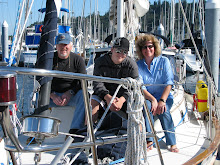Sept 29-30- Overnight Sail from Morro Bay to Prisoner’s Harbor, Santa Cruz Island and Rounding Point Conception.
Departure from Morro Bay
We waited for the fog to lift hence our tardy departure at 11:00AM. As we motored out towards the entrance we could see Morro Rock and the PG&E Power Plant stacks, both hidden by fog when we arrived. Also, the boats anchored in the channel are visible now and we see more sailboats flying the green Baja Ha-Ha pennant. We’re starting to introduce ourselves to the sailors that we see flying the pennant. Soon 168 sailboats will gather in San Diego for the run south to Cabo San Lucas. We’re getting very exciting!


Point Conception and the Painted Cave
On this leg we passed Point Conception, the last challenging section of coast before entering calmer waters of Southern California. Point Conception is 60 nautical miles south of Morro Bay we motored around it at 9:00PM, it was nearly dead calm. The wind gods must be sleeping. Many guide books call Point Conception the “Cape Horn of the North Pacific” others that have sailed this stretch of water and have been becalmed like us sarcastically call it the Cape Horn of “Southern California”. We believe that once we pass Point Conception we will no longer have stormy seas to contend with. It would be good if that were true. That’s why we chose a point south of Point Conception for Cindy to join the cruise.
We motored almost this entire leg from Morro Bay to Santa Cruz Island. Just as soon as we passed Point Conception we started seeing offshore oil platforms in the distance. At night you can see them 15 miles away, lit up like Christmas trees. A blazing torch that burns waste oil adds to the light we see coming from the platforms. Periodically, the torch burns so bright that it lights up the water all around the platform. First we see one platform, then a few more until we reach Santa Cruz Island and see six or seven platforms stretching out across the channel near Santa Barbara.
The logbook shows that we arrived at the west end of Santa Cruz Island, at 8:30 AM on Sept 30th. Santa Cruz Island is one of a group of channel islands south of Santa Barbara, other members of the group include: San Miguel, Santa Rosa and Anacapa Islands. The largest sea cave in North America is a few miles to the east on Santa Cruz Island, it’s called “Painted Cave” on our nautical chart. The entrance is over 80 feet high and is hundreds of feet deep, but there’s no place nearby to anchor. We stopped for a few minutes, took a few pictures of the entrance and continued to our anchorage.
We planned to anchor for the night at Pelican Bay but after motoring around the bay to look for a suitable spot to drop our hook we decided to find a better anchorage. Pelican Bay was deeper than we liked and many boats were already anchored there. The skipper of a motor boat anchored in the middle of the bay told us he was using his backup ground tackle and that he let out a lot of rode, meaning his boat would swing over a large area. We didn’t want to be anchored anywhere near that boat so we motored on.
The next bay to the east, Prisoners Harbor, looked just perfect for us. The water is 15-20 feet deep throughout most of the anchorage and the bottom is gradually sloping sand, so it’s not likely we would drag our anchor. A large dock is situated in the middle of the bay and no other boats were at anchor in the bay. We dropped our hook at 10:50AM. Bill and I inflated the dinghy and rowed to shore to stretch our legs, while Alex caught up on his sleep from his night watch.
Once on shore we discovered that part of the island was accessible to visitors but other parts were not. East of Prisoners Harbor is a National Park and visitors are allowed to hike and camp overnight. West of the harbor the land is owned by the Nature Conservancy and visitors are not allowed. A gate just a few hundred feet into the island blocks off access to the restricted part of the island. I told Bill that this island would make a good Jurassic Park, he agreed. We followed a short trail up to a lookout point and took a few pictures of the dock and our boat, then hike back down. On the way back we spotted a fox, sneaking around the picnic tables. Later, when Alex took the dinghy to shore to fish he saw three foxes and scores of Humboldt Squid stranded along the shore. Later, we learned that the commercial fishermen go to the Channel Islands from Santa Barbara to fish for lobster, crabs, and halibut. Commercial squid boats with their bright lights can be seen at night, closer to the mainland coast fishing for squid.








0 Comments:
Post a Comment
Subscribe to Post Comments [Atom]
<< Home